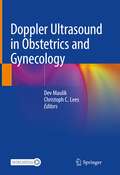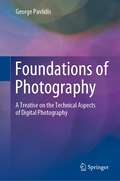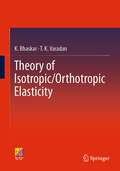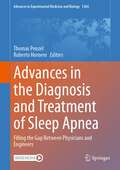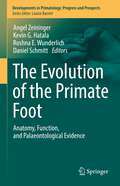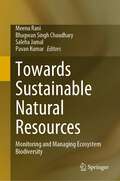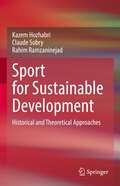- Table View
- List View
Doppler Ultrasound in Obstetrics and Gynecology
by Dev Maulik Christoph C. LeesExpanded and updated edition highlighting current standards and breakthroughs in the technology of Doppler ultrasound Includes latest advances in 3D and color doppler and 4D fetal echocardiography Includes more than 500 illustrations, including more than 150 in color
Physics Teacher Education: What Matters? (Challenges in Physics Education)
by Joan Borg Marks Pauline Galea Suzanne Gatt David SandsThis book presents the most up-to-date research contributions focusing on progress in the field of physics education. It provides researches and results that are based on the most relevant matters in physics teacher education and how these matters can be improved for the satisfaction of both teachers and learners. The work is the by-product of the collaboration between GIREP (the International Research Group on Physics Teaching) and the University of Malta. The contributing authors present close examinations of the following topics: ICT and multimedia in teacher education; experiments and laboratory work in teacher education; the role of quantum mechanics in teaching and learning physics; formal, non-formal and informal aspects of physics education at the primary level; strategies for pre-service physics teacher education at all levels; and in-service teacher professional learning strategies. The editors hope that many different stakeholders within scientific academia will find something of value in this compilation of the current most advanced ideas in physics education.
The Supercontinuum Laser Source: The Ultimate White Light
by Robert R. AlfanoThis book, now in its fourth edition, is a well-known classic on the ultrafast nonlinear and linear processes responsible for supercontinuum generation. The book begins with chapters reviewing the experimental and theoretical understanding of the field along with key applications developed since the discovery of the supercontinuum effect. The chapters that follow cover recent research activity on supercontinuum phenomena, novel applications, and advances achieved since the publication of the previous edition. The new chapters focus on: filamentation in gases, air, and condensed media; conical emission by four-wave mixing and X-waves; electronic self-phase mechanism; higher harmonics generation; attosecond laser pulses; complex vector beam supercontinuum; higher order self-phase modulation and cross-phase modulation; nonlinear supercontinuum interference in uniaxial crystals; new nonlinear microscopes involving supercontinuum and ultrafast lasers with biomedical applications; and other current supercontinuum applications in communications. The Supercontinuum Laser Source is a definitive work by one of the discoverers of the white light effect. It is indispensable reading for any researcher or student working in the field of ultrafast laser physics. Chapter 6 is available open access under a Creative Commons Attribution 4.0 International License via link.springer.com.
Foundations of Photography: A Treatise on the Technical Aspects of Digital Photography
by George PavlidisThis book offers an in-depth technical presentation of photography and details about the inner workings of the digital camera, while keeping the artistic principles in mind. Departing from the current stream, the book treats photography as a highly scientific and technical subject, and serves as a reference to those who seek for an understanding of the technical aspects relating to the photographic camera, the beating heart of photography. It offers insight on why the photographs are created the way they are, highlighting also the limitations. As the author of this book is an image technology scientist and a photography enthusiast who has been teaching photography for a long time, this treatise reflects his own constant search and study for an in-depth understanding.
Reindeer Hunters of the Ice Age in Europe: Economy, Ecology, and the Annual Nomadic Cycle
by Laure FontanaThis book undertakes a thorough study of Reindeer in the Upper Pleniglacial and Tardiglacial societies in France. It addresses two main topics – the economy of animal resources within the societies and the exploitation of Reindeer organized within the annual cycle, in terms of space and time, between 30,000 and 14,000 cal BP in France. The author proposes an analysis and hypothesis regarding the economy of animal resources and the nomadic cycle of the last Paleolithic hunter-gatherer societies, in order to identify a “Reindeer system.”The author discusses the relationship between Reindeer and human mobility and offers some conclusions regarding the annual cycles of nomadism. The volume scrutinizes the distinct eco systems in three regions and its effects on the movements of both human and animal. This book is of interest to zooarchaeologists and prehistorians.
From Net Neutrality to ICT Neutrality
by Patrick Maillé Bruno TuffinThis book discusses the pros and cons of information and communication (ICT) neutrality. It tries to be as objective as possible from arguments of proponents and opponents, this way enabling readers to build their own opinion. It presents the history of the ongoing network neutrality debate, the various concepts it encompasses, and also some mathematical developments illustrating optimal strategies and potential counter-intuitive results, then extends the discussion to connected ICT domains. The book thus touches issues related to history, economics, law, networking, and mathematics. After an introductory chapter on the history of the topic, chapter 2 surveys and compares the various laws in place worldwide and discusses some implications of heterogeneous rules in several regions. Next, chapter 3 details the arguments put forward by the participants of the net neutrality debate. Chapter 4 then presents how the impact of neutral or non-neutral behaviors can be analyzed mathematically, with sometimes counter-intuitive results, and emphasizes the interest of modeling to avoid bad decisions. Chapter 5 illustrates that content providers may not always be on the pro-neutrality side, as there are situations where they may have an economic advantage with a non-neutral situation, e.g. when they are leaders on a market and create barriers to entry for competitors. Another related issue is covered in chapter 6, which discusses existing ways for ISPs to circumvent the packet-based rules and behave non-neutral without breaking the written law. Chapter 7 gives more insight on the role and possible non-neutral behavior of search engines, leading to another debate called the search neutrality debate. Chapter 8 focuses on e-commerce platforms and social networks, and investigates how they can influence users’ actions and opinions. The issue is linked to the debate on the transparency of algorithms which is active in Europe especially. Chapter 9 focuses on enforcing neutrality in practice through measurements: indeed, setting rules requires monitoring the activity of ICT actors in order to sanction non-appropriate behaviors and be proactive against new conducts. The chapter explains why this is challenging and what tools are currently available. Eventually, Chapter 10 briefly concludes the presentation and opens the debate.
Reference Materials in Measurement and Technology: Proceedings of the Fourth International Scientific Conference
by Sergey V. Medvedevskikh Egor P. Sobina Olga N. Kremleva Mikhail V. OkrepilovThe book covers in particular state-of-the-art scientific research about product quality control and related health and environmental safety topics, including human, animal and plant safety assurance issues. These conference proceedings provide contemporary information on the general theoretical, metrological and practical issues of the production and application of reference materials.Reference materials play an integral role in physical, chemical and related type of measurements, ensuring their uniformity, comparability and the validity of quantitative analysis as well as, as a result, the objectivity of decisions concerning the elimination of technical barriers in commercial and economic, scientific and technical and other spheres of cooperation. The book is intended for researchers and practitioners in the field of chemistry, metrologists, technical physics, as well as for specialists in analytical laboratories, or working for companies and organizations involved in the production, distribution and use of reference materials.
Intellectual Property Protection for Plant Related Innovation: Fit for Future? (Law for Professionals)
by Michael Andreas KockThe book reviews the history, present, and likely future of intellectual property for plant-related inventions. It describes “what works” and “what does not work” in the current situation and analyzes whether the current intellectual property framework will be able to cope with the rise of genome editing/new breeding technologies (especially CRISPR Cas). Based on trend data, the analysis shows that the current system, including stakeholder initiatives, will most likely not be able to adapt to the technology change. It then evaluates different options for legislators to respond and proposes in detail a new holistic IP system which merges elements of the patent and the plant variety protection system into one new system.
Trends in Food Chemistry, Nutrition and Technology in Indian Sub-Continent (SpringerBriefs in Molecular Science)
by Suni Mary Varghese Salvatore Parisi Rajeev K. Singla A. S. BegumThis brief outlines the state-of-art of the food industry within the Indian Sub-continent, providing a detailed insight into the current science of nutrition and industrial technology.The Hygiene, Integrity, Traceability and Sharing (HITS) strategy has been proposed recently as a coordinated and powerful tool to contextualize the plethora of different menaces for the food consumer. The book examines this approach from eight different perspectives, with a particular emphasis on the Indian Subcontinent. Topics such as food additives, the importance of water in the food industry, the use of antioxidants, and novel food preservation methods are used to illustrate these points of view.This book is particularly appealing as a guide for graduate and undergraduate courses covering food production, food safety, and the training of teachers working in these science areas.
A Geographic Perspective of Cuba’s Changing Landscapes (Landscape Series #33)
by Jennifer GebeleinThis book is based on research that gives the reader a nonfiction view of how Cuba’s landscape has changed since the time when Columbus first set foot on the island and encountered the Indigenous peoples who lived there in 1492 to present day.An analysis of landscape change over time is presented and that transformation from a heavily forested island to less than (currently) 18% forest cover is described. The government has established a system of protected areas and strong governmental controls over environmental policies and the manner with which the island can be built upon by foreign investors, urban expansion projects, or natural resource exploitation.Current GIS and remote sensing research of Cuba’s atmosphere, physical landscape and aquatic features is provided to underscore the complex environmental structures that epitomize Cuba. The author discusses past, present and future impact factors including history, technological assessments, laws and policies, relationships with other countries and education.
A New Kirchhoff-Love Beam Element and its Application to Polymer Mechanics (Mechanics and Adaptronics)
by Matthias C. SchulzThe novel finite element formulations fall into the category of geometrically exact Kirchhoff-Love beams. A prominent characteristic of this category is that the absence of shear deformation is strongly enforced by removing two degrees of freedom. Further, the corresponding beam theories exhibit not only translational but also rotational degrees of freedom and their configurations thus form a non-additive and non-commutative space. Sophisticated interpolation schemes are required that need to be tested not only for locking, spatial convergence behavior, and energy conservation, but also for observer invariance and path-independence. For the three novel beam element formulations all these properties are analytically and numerically studied and confirmed, if applicable. Two different rotation parameterization strategies are employed based on the well-known geodesic interpolation used in many Simo-Reissner beams and the lesser known split into the so-called \textit{smallest rotation} and a torsional part. Application of the former parameterization results in a mixed finite element formulation intrinsically free of locking phenomena. Additionally, the first geometrically exact Kirchhoff-Love beam element is presented, which strongly enforces inextensibility by removing another degree of freedom. Furthermore, the numerical efficiency of the new beam formulations is compared to other beam elements that allow for or suppress shear deformation. When modeling very slender beams, the new elements offer distinct numerical advantages.Standard molecular dynamics simulations, which are commonly used to study polymers, suffer from a lack of a careful mathematical basis and the use of an expensive explicit time integration scheme. To circumvent these shortcomings and to be able to simulate stretching experiments on relevant time scales, the problem is described by a stochastic partial differential equation, which can be solved using the finite element method with a backward Euler temporal discretization. In detail, the polymer is represented by a Kirchhoff-Love beam with a linear elastic constitutive model. Inertial and electrostatic forces are neglected. It is deformed by a distributed load mimicking collisions with molecules of the surrounding fluid. Naturally, this load heavily fluctuates over time and space and mean values need to be computed in a Monte Carlo manner. To vastly speed up the fitting process to experimental data in a Bayesian framework, a surrogate model based on a Gaussian process is set up, which directly computes the mean values for given material parameters. The uncertainties and correlations of the material parameters are studied and compared to the literature.
Theory of Isotropic/Orthotropic Elasticity
by K. Bhaskar T. K. VaradanThis book provides a lucid introduction to the theory of elasticity as applied to isotropic, specially orthotropic and laminated structures. With an application-oriented approach, the contents emphasize the need for rigorous analysis and illustrate its utility for a variety of problems. The simultaneous treatment of comparable isotropic and orthotropic problems enables one to easily visualize the changes in structural behaviour due to material orthotropy. Though intended as a textbook for graduate engineering study, this book is valuable as a self-study aid for practicing engineers as well.
Strength of Materials: A Concise Textbook
by T. K. Varadan K. BhaskarThis textbook has been written for the engineering students. This textbook covers the essentials of solid mechanics with reference to basic load-bearing members—straight bars, thin-walled cylindrical and spherical pressure vessels, circular shafts, beams undergoing simple bending, and columns. It concisely elucidates the corresponding fundamental assumptions, important equations, and their range of validity without formal derivations. Subsequently, this textbook contains several carefully selected examples to illustrate sequence of steps in the analysis of forces, stresses and displacements, or stability. It further deals with combined loading, stress and strain transformations, energy methods, and failure analysis using commonly employed criteria. This textbook is a handy, yet complete, resource for graduate and postgraduate engineering students. It will also be a ready reference for a practicing engineers or graduate students preparing for an interview or a competitive examination.
Hybrid AC/DC Power Grids: Stability and Control Aspects (Power Systems)
by Lasantha Meegahapola Siqi Bu Mingchen GuThis book covers modeling, control and stability aspects of hybrid AC/DC power networks. More specifically, this book provides an in-depth analysis of the stability and control aspects of hybrid AC/DC power grids, with comprehensive coverage of theoretical aspects of conventional stability issues (e.g., small-signal stability, voltage stability and frequency stability), emerging stability issues (e.g., converter associated stability) and control strategies applied in this emerging hybrid AC/DC power grids. This book takes a more pragmatic approach with a unique compilation of timely topics related to hybrid AC/DC networks compared with other books in this field. Therefore, this book provides the reader with comprehensive information on modeling, control and stability aspects which need to consider when modeling and analysis of hybrid AC/DC power grids for power system dynamics and stability studies. Each chapter provides fundamental stability theories, some worked examples and case studies to explain various modeling, analysis and control concepts introduced in the chapter. Therefore, postgraduate research students, power system researchers and power system engineers benefit from the materials presented in this book and assist them to model and device new control strategies to overcome the stability challenges of the emerging hybrid AC/DC power grid.
Principles of National Forest Inventory Methods: Theory, Practice, and Examples from Estonia (Managing Forest Ecosystems #43)
by Allan SimsThis Monograph explains the statistical theory behind the National Forest Inventory (NFI) data collection and compares different methods for modelling and inventory design. The author also explains how natural uncertainty in measurement and modelling can affects the results. Forests, as dynamic systems, are influenced by many unpredictable factors over time. Therefore, readers can use this book to develop the right framework of expectations, when using NFI data. The chapters give an outlook on traditional methods like sample plots, but also consider newer approaches like remote sensing. By merging these different techniqes, NFI datasets can become more reliable and facetted. One of the most contemporary developments in the field, is the use of continuous plots that offer live data at all times. Whether this data should be open to the public, is another discussion point that the author addresses. Offering a perspective from Estonia, readers will find practical examples for all discussed methods. This bridge from theory to practice, makes the volume a useful resource for scientists and decision makers in the forestry sector.
Advances in the Diagnosis and Treatment of Sleep Apnea: Filling the Gap Between Physicians and Engineers (Advances in Experimental Medicine and Biology #1384)
by Thomas Penzel Roberto HorneroThe book focuses on biomedical innovations related to the diagnosis and treatment of sleep apnea. The latest diagnostic tools are described, including sleep laboratory equipment, wearables, and even smartphone apps. Innovative medical devices for treatment are also covered, such as CPAP, Auto-PAP, hypoglossal nerve stimulation, phrenic nerve stimulation, acoustic brain stimulation and electrical brain stimulation. This is an ideal book for biomedical engineers, pneumologists, neurologists, cardiologists, physiologists, ENT physicians, pediatrics, and epidemiologists who are interested in learning about the latest technologies in treating and diagnosing sleep apnea.
The Evolution of the Primate Foot: Anatomy, Function, and Palaeontological Evidence (Developments in Primatology: Progress and Prospects)
by Angel Zeininger Kevin G. Hatala Roshna E. Wunderlich Daniel SchmittThe human foot is a unique and defining characteristic of our anatomy. Most primates have grasping, prehensile feet, whereas the human foot stands out as a powerful non-grasping propulsive lever that is central to our evolution as adept bipedal walkers and runners and defines our lineage. Very few books have compiled and evaluated key research on the primate foot and provided a perspective on what we know and what we still need to know. This book serves as an essential companion to “The Evolution of the Primate Hand” volume, also in the Developments in Primatology series. This book includes chapters written by experts in the field of morphology and mechanics of the primate foot, the role of the foot in different aspects of primate locomotion (including but not limited to human bipedalism), the “hard evidence” of primate foot evolution including fossil foot bones and fossil footprints, and the relevance of our foot’s evolutionary history to modern human foot pathology.This volume addresses three fundamental questions: (1) What makes the human foot so different from that of other primates? (2) How does the anatomy, biomechanics, and ecological context of the foot and foot use differ among primates and why? (3) how did foot anatomy and function change throughout primate and human evolution, and why is this evolutionary history relevant in clinical contexts today?This co-edited volume, which relies on the insights of leading scholars in primate foot anatomy and evolution provides for the first time a comprehensive review and scholarly discussion of the primate foot from multiple perspectives. It is accessible to readers at different levels of inquiry (e.g., undergraduate/graduate students, postdoctoral research, other scholars outside of biological anthropology). This volume provides an all-in‐one resource for research on the comparative and functional morphology and evolution of the primate foot.
Towards Sustainable Natural Resources: Monitoring and Managing Ecosystem Biodiversity
by Meenu Rani Bhagwan Singh Chaudhary Saleha Jamal Pavan KumarNatural resources not only contribute to overall growth of the economy but also help reduce poverty by providing employment and food security to populations on the continent, and is thus the most inclusive growth sector of the economy of Asian countries. Global weather and climate studies are also increasingly being considered a vital source of information to understand the earth’s environment, in particular in the framework of weather and climate studies, land use transformation and human influence across these areas. Satellite earth observing systems provide a unique tool to monitor these changes. This book includes significant and up to date contributions in the field of sustainable natural resources conservation across the globe. While the range of applications and innovative techniques is constantly increasing, this book provides a summary of key case studies where satellite data offers critical information to help understand the causes and effects of those environmental changes, allowing us to reflect on how to minimize their negative impacts. This book is of interest to researchers and practitioners in the field of remote sensing, geographical information, meteorology, and environmental sciences. Scientists and graduate to post-graduate-level students in environmental science will also find valuable information in this book.
Sport for Sustainable Development: Historical and Theoretical Approaches
by Kazem Hozhabri Claude Sobry Rahim RamzaninejadThis book looks at the potential of sport to contribute to wide-ranging development outcomes, which have been recognized across international policy declarations, most significantly in the 2030 UN Agenda for Sustainable Development. It provides a theoretical approach to sport and development. It begins by addressing the basic concepts of sport development and sustainability and then discusses the potential contribution of sport to five prioritized SDGs (SDGs 3, 4, 5, 8 and 16) and the environment as one of the sustainable development pillars that may contribute to SDGs 6, 7, 11, 12, 13, 14 and 15. This academic resource provides a macro view to students and researchers of sports sciences to know more about the fundamental concepts of sustainable development goals, and to enhance their knowledge about sport as a conduit that can help achieve wider development outcomes rather than being an end in itself. This book is of interest to students and researchers of sports studies, from sociology to management, and researchers and policy makers interested in sport and sustainable development.
Visions and Strategies for a Sustainable Economy: Theoretical and Policy Alternatives (Global Institute for Sustainable Prosperity)
by Nikolaos Karagiannis John E. KingThe multidisciplinary edited book Visions and Strategies for a Sustainable Economy: Theoretical and Policy Alternatives provides a thorough examination – at the theoretical and, especially, policy levels – of a number of key topics related to a sustainable economy and a better society. With important contributions by distinguished academics, the book presents alternative views, provides an assessment of contemporary realities in an era of ecological emergency, and offers visions, strategies, and realistic policies towards a better economy and society while paying special attention to a “green new deal” for different areas.
Planning Cities in Africa: Current Issues and Future Prospects of Urban Governance and Planning (The Urban Book Series)
by Genet Alem Gebregiorgis Stefan Greiving Ally Hassan Namangaya Wilbard Jackson KombeThis open access book provides insights into challenges, threats and opportunities of urban development in Africa. It discusses how and why African cities need localised urban planning concepts and theories to deal with challenges and threats of rapid urbanisation and climate change. The book delivers an in-depth view of the nature and gaps of the framework on which current planning practice and education in Africa are based. With that, it discusses the potentials of African cities to mobilise local knowledge, resources and capacity building for sustained and resilient urban growth.This work is addressed to educationists and practitioners in the field of urban development management, climate change adaptation and urban resilience. Specifically, such audiences include researchers, spatial planners, graduate students and member of civil societies working on urban development management.
Handbook of Waste Biorefinery: Circular Economy of Renewable Energy
by Eduardo Jacob-Lopes Leila Queiroz Zepka Mariany Costa DepráThis handbook discusses the latest developments in biorefinery technologies for waste-to-energy conversion. The growing global population and the accompanying increase in consumption and waste production make it urgent to find the best possible use of our resources. A sustainable waste management under the biorefinery concept has great potential to support a sustainable circular economy and green energy production.This handbook is divided into four parts. First, the reader is introduced to the fundamentals and recent trends of waste-to-energy technologies. The second part describes in detail the current status, challenges, and potential of the different feedstocks used for waste-to-energy conversion. Here, municipal solid waste, sewage sludge, oils and greases generated during food preparation, industrial wastewaters, and agricultural wastes, to name a few, are introduced. In the third part, numerous waste-to-energy technologies are discussed in detail, including anaerobic digestion, composting, gasification, plasma technology, thermal cracking, and others. Advantages and optimization potentials of these technologies for efficient residue management, quality and yield are highlighted.Finally, the handbook discusses social, environmental and economic aspects of waste-to-energy biorefinery technologies. Readers will learn more about the major bottlenecks and solutions in bioenergy commercialization, the logistics of biomass supply and the carbon footprint of waste biorefineries. The ideas and technologies presented in this book contribute to the UN Sustainable Development Goal (SDG) of "Affordable and Clean Energy".This book is a useful reference for postgraduate students and researchers interested in biorefinery and biofuel technologies, both in academia- and commercial laboratories. Early career scientists can use it to fast track into the field. Advanced scientists will find it helpful in gaining a broader overview of the field beyond their area of specialization.
PI3K and AKT Isoforms in Immunity: Mechanisms and Therapeutic Opportunities (Current Topics in Microbiology and Immunology #436)
by Margarita Dominguez-VillarThis book provides an essential overview of the role of phosphoinositide-3-phosphate kinase (PI3K) isoforms in modulating the function of immune system cells and their involvement in disease.PI3K is a family of kinases involved in basic cellular processes such as proliferation, migration and cell death. Recent work has highlighted the multiple roles of PI3K classes and subunits and their involvement in the immune response to the body’s own and foreign antigens and diseases such as cancer and autoimmunity. This book offers a detailed introduction to the biology of the three PI3K classes, followed by an extensive discussion of the diverse roles of AKT and PI3K isoforms in immune cells. Based on this knowledge, it subsequently explains in more detail how specific isoforms are connected to immune-mediated diseases. The book concludes by highlighting the latest advances in the production of isoform-specific inhibitors and their use in various human diseases. This book is intended as a reference guide for students and researchers interested in the multifaceted aspects of PI3K biology.
Nuclear, Chromosomal, and Genomic Architecture in Biology and Medicine (Results and Problems in Cell Differentiation #70)
by Malgorzata Kloc Jacek Z. KubiakThis volume reviews the latest research on the functional implications of nuclear, chromosomal and genomic organization and architecture on cell and organismal biology, and development and progression of diseases.The architecture of the cell nucleus and non-random arrangement of chromosomes, genes, and the non-membranous nuclear bodies in the three-dimensional (3D) space alters in response to the environmental, mechanical, chemical, and temporal cues. The changes in the nuclear, chromosomal, or genomic compaction and configuration modify the gene expression program and induce or inhibit epigenetic modifications. The intrinsically programmed rearrangements of the nuclear architecture are necessary for cell differentiation, the establishment of cell fate during development and maturation of tissues and organs including the immune, muscle, and nervous systems.The non-programmed changes in the nuclear architecture can lead to fragmentation of the nucleus and instability of the genome and thus cause cancer. Microbial and viral infections can lead to a clustering of centromeres, telomeres and ribosomal DNA and alter the properties of the nuclear membrane, allowing large immobile macromolecules to enter the nucleus. Recent advances in next-generation sequencing technologies combined with nucleus/chromosome conformation capture, super-resolution imaging, chromosomal contact maps methods, integrative modeling, and genetic approaches, are uncovering novel features and importance of nuclear, chromosomal and genomic architecture. This book is an interesting read for cell biologists, researchers studying the structure and function of chromosomes, and anyone else who wants to get an overview of the field of nuclear, chromosomal and genomic architecture.
Microbial Production of High-Value Products (Microbiology Monographs #37)
by Bernd H. A. Rehm David WibowoThis edited volume emphasizes how microorganisms have become a reliable pillar of biotechnology. The authors discuss advances in synthetic biology and genetic engineering that have made it possible to reprogram the microbial cellular capabilities. This enables an economically viable production of high-value products at an industrial level.The first part of the book provides an overview of synthetic biology and genome editing tools for engineering microbial cell factories in modern fermentation. Readers also learn how high-throughput bioprocessing methods are used to recover and purify microbial products.The remaining parts of this book explore the implementation and challenges of these upstream and downstream processing techniques for manufacturing high-value products. Cost-effectiveness and quality-control are key factors, when discussing the production of low-molecular-weight products, biopharmaceuticals, biopolymers and protein-based nanoparticles.This book is a valuable resource for biotechnologists both in the industry and in academia.
